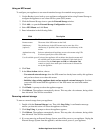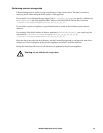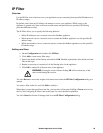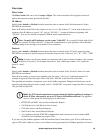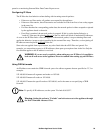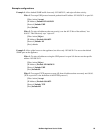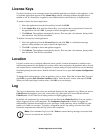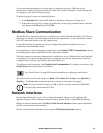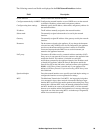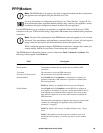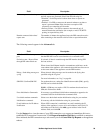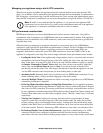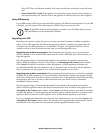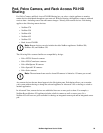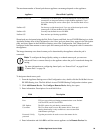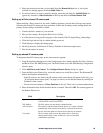
88NetBotz Appliance User’s Guide
The following controls and fields are displayed in the Edit Network Interface window:
Field Description
Enable Interface Select to enable this network interface.
Configure automatically via DHCP Configure the network interface to use a DHCP server on the network
to obtain its IP address, subnet mask, and gateway address.
Configure using these settings Manually specify the IP address, subnet mask, and gateway address for
the network interface.
IP address The IP address manually assigned to the network interface.
Subnet mask The manually-assigned subnet mask to be used by the network
interface.
Gateway The manually-assigned IP address of the gateway used by the network
interface.
Hostname The host name assigned to the appliance. If you change the hostname
value and are using a DHCP server for IP configuration, the appliance
uses the new hostname until the next time it renews its IP address
license and requests that the DHCP server use the hostname you
entered as the appliance hostname.
NAT proxy The name or IP address used by a network address translation (NAT)
Proxy server in your network to let users connect to the appliance from
outside the firewall. This address is included in e-mail alert
notifications generated by the appliance instead of the IP address used
to identify the appliance within the firewall. Recipients outside the
firewall can click on the link in the e-mail and connect to the appliance.
N
OTE: A NAT Proxy Name is needed only if your appliances are
behind a NAT Proxy firewall. If you are not using a NAT Proxy, leave
this field blank.
Speed and duplex Force the network interface to use specific speed and duplex settings, or
configure the interface to auto-negotiate these settings.
MTU The Maximum Transmission Unit (MTU), the largest physical packet
size, measured in bytes, that a network can transmit. Messages larger
than the MTU are divided into smaller packets before being sent. Every
network has a different MTU set by the network administrator. Ideally,
the MTU should be the same as the smallest MTU of all the networks
between your machine and the final destination of a message. Messages
larger than one of the intervening MTUs are broken up or fragmented,
which slows transmission speeds.



